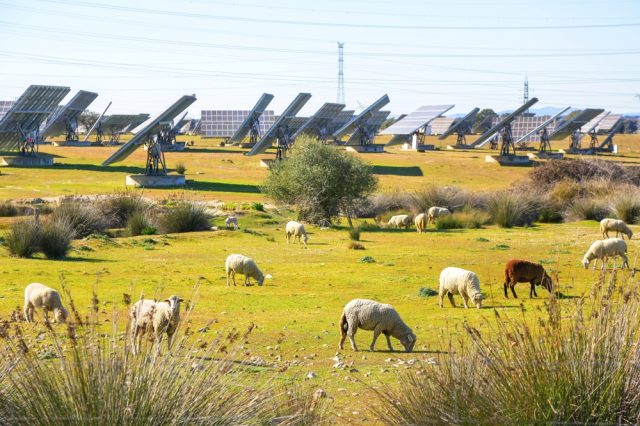
Innovative practices such as “solar grazing,” also known as agrivoltaics, are playing a growing role in reducing dependence on fossil fuels. By integrating livestock grazing with solar power infrastructure, this approach is producing numerous benefits for agriculture, animal welfare, and environmental sustainability.
Although solar grazing is relatively new in the United States, many European countries have been practising it for years. The system involves using animals—mainly sheep—to control vegetation under and around solar panels. Rapid vegetation growth can hinder the performance of solar installations by obstructing sunlight and increasing fire hazards, particularly in regions with dry conditions. Traditional solutions, such as mechanical lawnmowers, have proven less effective in reaching tight or uneven spaces around the panels. Sheep, however, can easily access these areas and keep the land clear without harming the equipment. Their presence serves as a natural, low-impact maintenance solution that improves overall solar farm efficiency.
The benefits of solar grazing go beyond maintenance, particularly when it comes to enhancing soil health. As the sheep graze, they naturally fertilise the ground, supporting soil regeneration. Healthier soil leads to better forage quality, which in turn improves the well-being of the animals. Research has shown that sheep grazing under solar panels experience increased wool yields and consume higher-quality forage, thanks to improved soil conditions and the microclimate created by the panels’ shade. This mutually beneficial relationship boosts both agricultural productivity and energy efficiency, offering farmers and solar operators a practical way to optimise land use.
Solar grazing also delivers notable economic benefits. Solar farm operators can reduce maintenance costs by replacing mechanical mowing with grazing animals. At the same time, farmers can generate additional income by leasing their land or offering their livestock for vegetation management. A study by Cornell University found that farmers can earn between $300 and $500 per acre annually through solar grazing partnerships. This extra income provides a financial cushion for farmers, helping them navigate challenges such as fluctuating commodity prices and climate-related risks.
The practice also holds considerable environmental potential. Studies indicate that soils under solar panels managed through grazing store significantly more carbon—up to 80% more—than those managed with traditional methods. This increased carbon storage helps mitigate climate change by reducing greenhouse gas levels. Additionally, the shade provided by solar panels helps retain moisture in the soil, minimising erosion and promoting plant growth. This healthier environment supports a greater presence of pollinators, which are essential for maintaining biodiversity and agricultural productivity.
Several European countries, including Portugal, Greece, and France, have successfully implemented solar grazing on a wide scale. Companies such as Spain’s Iberdrola have integrated sheep grazing into their photovoltaic projects, recognising the ecological and economic benefits. In regions where both agriculture and renewable energy are vital to the economy, such as Greece, solar grazing has proven to be a cost-effective strategy for maintaining solar farms while supporting local ecosystems. These examples demonstrate how the practice can be scaled to balance energy production and agricultural sustainability.
The broader adoption of solar grazing also aligns with efforts to reduce the use of chemical fertilisers and fossil-fuel-powered machinery. By lowering the carbon footprint of both energy and agricultural operations, solar grazing supports the transition toward more sustainable farming practices. Furthermore, collaboration between solar operators and farmers fosters opportunities for knowledge-sharing and innovation, enabling both sectors to benefit from advancements in technology and sustainable management techniques.
Looking to the future, solar grazing has the potential to become a global model for integrating renewable energy with agricultural development. Its ability to create a synergistic relationship between livestock, land management, and clean energy makes it particularly appealing for regions striving to achieve both economic growth and environmental sustainability. As more countries explore strategies to balance ecological conservation with economic progress, solar grazing offers a proven, practical solution that meets these dual objectives.
In conclusion, solar grazing is reshaping how renewable energy projects can coexist with agricultural activities. By enhancing solar farm efficiency, improving soil health, and providing new revenue streams for farmers, this practice contributes to a more resilient and sustainable future. Its environmental benefits, including carbon sequestration and biodiversity protection, further highlight its role in addressing global challenges such as climate change and food security. As awareness of its advantages continues to grow, solar grazing could play a central role in sustainable development strategies worldwide.



 Subscribe
Subscribe